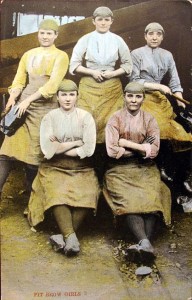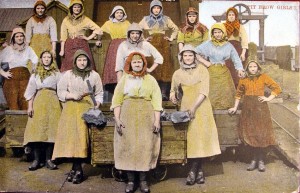 Rosemary gave us a thought provoking insight into the harsh realities of women and children working in coal mines over the centuries. In the 17th and 18th centuries, whole families worked underground – men, women and children, some as young as 6 years old. Concern for safety was negligible with many of the mines were in isolated communities and unwelcoming to inquisitive strangers. Conditions were atrocious and there were graphic descriptions of women hauling wagons/tubs of coal by a belt around their waist and a chain passing through their legs. They worked on their hands and knees, in water, soaked through , with numerous blisters. Women carried baskets of coal on their backs from the coal face and climbed ladders out of the mines. We have to remember the women were often wives, mothers with many children and a home to run after her shift at the pit. They were shattered.
Rosemary gave us a thought provoking insight into the harsh realities of women and children working in coal mines over the centuries. In the 17th and 18th centuries, whole families worked underground – men, women and children, some as young as 6 years old. Concern for safety was negligible with many of the mines were in isolated communities and unwelcoming to inquisitive strangers. Conditions were atrocious and there were graphic descriptions of women hauling wagons/tubs of coal by a belt around their waist and a chain passing through their legs. They worked on their hands and knees, in water, soaked through , with numerous blisters. Women carried baskets of coal on their backs from the coal face and climbed ladders out of the mines. We have to remember the women were often wives, mothers with many children and a home to run after her shift at the pit. They were shattered.
Men at the coal face were often naked and were assisted by girls of 6 and women up to 21, bare breasted. The girls and women were vulnerable and familiarity was common.
By the beginning of the 19th century, conditions were still primitive and dangerous with women and children working 12 hour days for lower wages than men. A freak accident in 1838 in a mine in Silkstone near Barnsley ,when 11 girls and 16 boys were killed, brought to the fore the whole issue of children working in mines . Queen Victoria ordered an enquiry. A royal commission was set up chaired by Lord Ashley-Cooper primarily with the directive to look at children working in the coal mines. The scope was later expanded to look at the employment of women in the mines. This was thought to be more concerned with Victorian prudery and morals rather than worries about the severe working conditions.
 The Mines Act of 1842 was passed which prohibited males under 10 and allfemales from working underground. Many mines obeyed the law but apparently the Wigan and Chorley coalfields continued to employ women underground for several years. Women continued to work on the surface pushing wagons and sorting coal until the 1930’s. In 1900 part of the act was repealed to give women the choice to work underground. The mining unions were not supportive to women working underground, believing men should be the wage earners. Women would be of greater value to society if they stayed at home.
The Mines Act of 1842 was passed which prohibited males under 10 and allfemales from working underground. Many mines obeyed the law but apparently the Wigan and Chorley coalfields continued to employ women underground for several years. Women continued to work on the surface pushing wagons and sorting coal until the 1930’s. In 1900 part of the act was repealed to give women the choice to work underground. The mining unions were not supportive to women working underground, believing men should be the wage earners. Women would be of greater value to society if they stayed at home.
Women in the 20th century were still employed in the collieries but in more traditional roles in canteens, offices and nursing but not in any duty down the pit. In 1943 the Bevin Boys were conscripted to work in the pits but not women. During the miners’ strikes of the 70’s and 80’s, women supported their men and communities in those uncertain times.
The mining industry has shrunk from 150,000 employees to 4000 in a handful of large and smaller pits . The coal mining industry has a noble history but blighted by the exploitation of men, women and children in its past.
